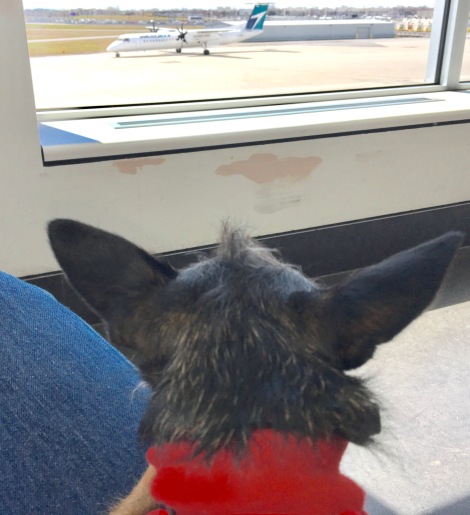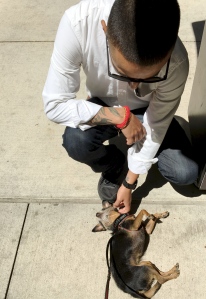According to recent stories in the media, booking a flight these days is more like buying passage on Noah’s Ark. That’s because the number of people flying with what they claim to be emotional support or service animals has increased both in numbers and species.
Airlines are worried about passengers trying to pass off pets as emotional support animals, which fly for free. But airlines are not always clear about what qualifies as an emotional support animal. And this is creating headaches for both airline personnel and the people who legitimately need their support animals when traveling.
Things really came to a head this past week when United Airlines denied a woman’s efforts to bring a peacock onto a flight departing from Newark Liberty International Airport.
In the wake of that and other cases in which large, unruly dogs have attacked passengers or people have claimed everything from snakes to large spiders to penguins or flying squirrels as their “support animals,” the major US carriers have announced they are tightening up their rules on animals in the cabins and placed many critters on a no-fly list.

Here are the steps passengers have to take to bring an emotional support animal into the main cabin on one of the three major US airlines:
- American — Passengers must submit a document signed by a licensed doctor or medical health professional which states that the passenger has a “mental health or emotional disability” and needs the animal “for emotional support or psychiatric service” on the flight or at the passenger’s destination. The document needs to have been signed within the past year and must be submitted at least 48 hours before the flight.
- Delta — Starting March 1, passengers will have to submit three documents if they wish to travel with an emotional support animal. In addition to a signed statement from a medical professional, passengers will have to provide vaccination dates and the contact information of the animal’s veterinarian and sign a statement that claims the animal is properly trained “to behave in a public setting” and take the passenger’s “direction upon command.” The document needs to have been signed within the past year and must be submitted at least 48 hours before the flight.
- United — Passengers must submit a document from a medical or mental health professional which states that the passenger has a “mental health-related disability” and that the emotional support animal “is necessary to the passenger’s mental health or treatment.” The document needs to have been signed within the past year and must be submitted at least 48 hours before the flight.
While passengers who can complete these steps will often be able to bring their emotional support animals into the cabin with them during a flight, there are some exceptions.
The US Department of Transportation says that airlines don’t have to let support animals into the cabin if they’re too large, heavy, disruptive, or threatening to the crew and passengers. And airlines don’t have to accept ferrets, reptiles, snakes, spiders, or sugar gliders as emotional support animals. American Airlines adds hedgehogs, insects, rodents, amphibians, non-household birds, and any animals with tusks, horns, or hooves, to its no-fly list.
So why would someone want to claim a pet as an emotional support or therapy animal?
Simple – those animals fly for free in the cabin. Most airlines charge extra for pets on a plane — anywhere from $50 to $150 one-way. That, when combined with the allure of having their pets as carry-on rather than flying in the cargo hold has resulted in more and more people faking it when it comes to service animals.
That’s a real problem. For one thing, those who fly the planes and take care of passengers have enough to do without worrying about wrangling disruptive critters. For another, it is going to make it harder for those of us with legitimate emotional support or service animals to fly with them.
Yes, Chiclet is a registered emotional support animal. This means, under FAA regulations, she can accompany me for free on flights. So far, I have ponied up the extra cash for her ticket because I think that is only fair. What is important is having her with me. She stays in her carrier, is quiet, well behaved and causes no issues at all in-flight.
So, before you decide to have your Belgian draught horse or St. Bernard declared a support animal so you can scam a free ticket for them, please consider the needs of those people who may otherwise not travel if not for the very real, very important service their animals provide.

What Chiclet would like you to know:
“I am a registered Emotional Support Animal. When I am wearing my vest, it means I’m working. What is my job? Basically, I provide comfort and a calming presence to my mom when we travel, I help her deal with the very real (and potentially debilitating) panic, anxiety & stress she experiences with ground and air travel. And I do a really, really good job! When I am with her, she thinks about me and is able to remain calm and focused. It makes me really happy and proud I can do that for her and we can share all sorts of adventures because of that. But you know what? There are animals that have even more important jobs! Those are the registered service animals. These are animals — usually dogs — that are individually trained to do work or perform tasks for the benefit of an individual with a disability, including a physical, sensory, psychiatric, intellectual, or other mental disability. Tasks performed can include, among other things, pulling a wheelchair, retrieving dropped items, alerting a person to a sound, reminding a person to take medication, or pressing an elevator button. How cool is that? Unlike me, registered service dogs are protected under the Americans with Disabilities Act. But we are all important to our humans, we are needed and we are really fed up with those people scamming the system. So, knock it off!”













